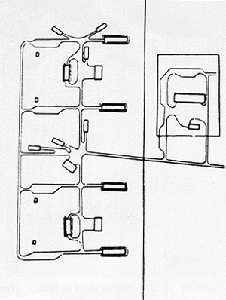
Test Range, Cape Canaveral, Florida. Closed out
August 4, 1988.

Missile Operation Base, Zasimovichi USSR. Closed out June
25, 1990. |
|
The fourth
type, closeout inspections, gave the inspecting party the
treaty right, after being officially notified that a
missile site had been eliminated, to send inspectors to
observe the status of the missile operating base, support
facility, or launcher production facility. If the
inspecting party chose not to exercise its right to
conduct a closeout inspection, the site was considered
closed after 60 days had elapsed from the time of the
elimination. Both the United States and the Soviet Union
exercised their treaty rights and conducted inspections
of every announced closed site. Most declarations fell
into the period after baseline and before the final
eliminations that came at the end of the third treaty
year--May 31, 1991. In a few instances, however, the
inspected party declared that the INF missiles and
associated equipment had been removed and all INF
activity had ceased prior to July 1, 1988, the start of
the initial baseline period. In those cases, the treaty
stipulated that the inspecting party had the right to
conduct one inspection, which would constitute both a
baseline and a closeout inspection of the site. In all
cases, the treaty stipulated explicit procedures for
closing out a missile site. Thirty days in advance, the
inspected party had to declare its intention to close or
eliminate the INF missile operating base or missile
support facility. To close the site it had to meet three
conditions. First, it had to remove all INF missiles,
launchers, and associated equipment from the site.
Second, it had to eliminate, through dismantling or
destruction, the INF missile support facilities, such as
missile or launcher structures, and launch pads. Finally,
it had to cease all activity relating to production,
flight-testing, training, repair, storage, or deployment
of INF missile systems. The site could be converted to
another purpose; the treaty only restricted use of the
site from any future activity associated with any INF
missile system. Once these conditions had been met and
the inspecting party officially notified, the missile
site or facility was considered under the treaty to be
closed out after 60 days had elapsed or after the site
had been subjected to a closeout inspection.1
The fifth type of on-site inspection was called
"short-notice." Short-notice inspections worked
within a quota system--20 per year allowed during the
first three treaty years, 15 per year for the next five
treaty years, and 10 per year for the last five years.
Their function was to give the inspecting party the right
to inspect any INF site, active or closed, to ascertain
the declared status of the site. These short-notice
inspections placed all of the Soviet and American INF
sites "at risk" to be inspected at any time,
within the quota limits. The inspection teams were
limited to 10 inspectors and they had 24 hours to conduct
the inspection.2
|



